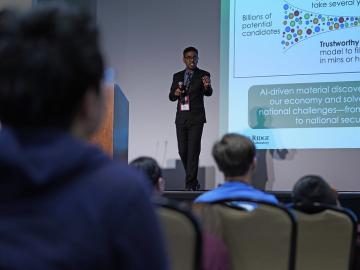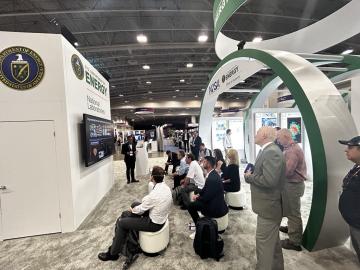
Filter News
Area of Research
- Advanced Manufacturing (2)
- Biological Systems (1)
- Biology and Environment (25)
- Clean Energy (45)
- Computational Biology (1)
- Electricity and Smart Grid (1)
- Fusion and Fission (5)
- Isotopes (5)
- Materials (32)
- Materials for Computing (6)
- National Security (13)
- Neutron Science (36)
- Nuclear Science and Technology (2)
- Quantum information Science (2)
- Supercomputing (35)
News Type
News Topics
- (-) Artificial Intelligence (49)
- (-) Biomedical (30)
- (-) Grid (27)
- (-) Mercury (7)
- (-) Microscopy (23)
- (-) Nanotechnology (20)
- (-) Neutron Science (52)
- (-) Polymers (11)
- (-) Security (12)
- (-) Space Exploration (12)
- (-) Transportation (32)
- 3-D Printing/Advanced Manufacturing (46)
- Advanced Reactors (9)
- Big Data (30)
- Bioenergy (52)
- Biology (61)
- Biotechnology (13)
- Buildings (25)
- Chemical Sciences (29)
- Clean Water (15)
- Climate Change (55)
- Composites (9)
- Computer Science (92)
- Coronavirus (18)
- Critical Materials (6)
- Cybersecurity (14)
- Decarbonization (50)
- Education (1)
- Emergency (2)
- Energy Storage (36)
- Environment (111)
- Exascale Computing (27)
- Fossil Energy (4)
- Frontier (26)
- Fusion (33)
- High-Performance Computing (45)
- Hydropower (5)
- Isotopes (29)
- ITER (2)
- Machine Learning (23)
- Materials (45)
- Materials Science (56)
- Mathematics (7)
- Microelectronics (3)
- Molten Salt (1)
- National Security (45)
- Net Zero (8)
- Nuclear Energy (61)
- Partnerships (19)
- Physics (35)
- Quantum Computing (21)
- Quantum Science (32)
- Renewable Energy (1)
- Simulation (32)
- Software (1)
- Statistics (1)
- Summit (31)
- Sustainable Energy (50)
- Transformational Challenge Reactor (3)
Media Contacts

At ORNL, a group of scientists used neutron scattering techniques to investigate a relatively new functional material called a Weyl semimetal. These Weyl fermions move very quickly in a material and can carry electrical charge at room temperature. Scientists think that Weyl semimetals, if used in future electronics, could allow electricity to flow more efficiently and enable more energy-efficient computers and other electronic devices.

The 26th annual National School on Neutron and X-ray Scattering School concluded on August 9, 2024. Each year, more than 200 graduate students in North America studying physics, chemistry, engineering, biological matter and more compete to participate in NXS. However, given limited space, only 60 can be accepted. The school exposes graduate students to neutron and X-ray scattering techniques through lectures, experiments, and tutorials.

Two ORNL teams recently completed Cohort 18 of Energy I-Corps, an immersive two-month training program where the scientists define their technology’s value propositions, conduct stakeholder discovery interviews and develop viable market pathways.

Power companies and electric grid developers turn to simulation tools as they attempt to understand how modern equipment will be affected by rapidly unfolding events in a complex grid.

Researchers at the Department of Energy’s Oak Ridge National Laboratory and partner institutions have launched a project to develop an innovative suite of tools that will employ machine learning algorithms for more effective cybersecurity analysis of the U.S. power grid.

Brian Sanders is focused on impactful, multidisciplinary science at Oak Ridge National Laboratory, developing solutions for everything from improved imaging of plant-microbe interactions that influence ecosystem health to advancing new treatments for cancer and viral infections.

In May, the Department of Energy’s Oak Ridge and Brookhaven national laboratories co-hosted the 15th annual International Particle Accelerator Conference, or IPAC, at the Music City Center in Nashville, Tennessee.

Researchers at ORNL and the University of Maine have designed and 3D-printed a single-piece, recyclable natural-material floor panel tested to be strong enough to replace construction materials like steel.

Prasanna Balaprakash, a national leader in artificial intelligence, or AI, spoke to some of the highest achieving students in the country at the National Science Bowl in Washington D.C.

ORNL researchers and communications specialists took part in the inaugural AI Expo for National Competitiveness in Washington D.C, May 7 and 8, to showcase and provide insight into how the lab is leading the way for utilizing the vast possibilities of AI.


